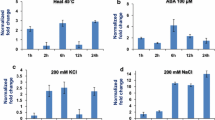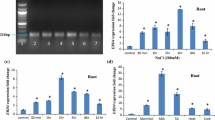Abstract
Glycine-rich RNA-binding proteins (GRPs) are involved in post-transcriptional regulation of genes, which have been found to play a role in stress response. However, whether GRPs can mediate some physiological responses related to salt stress tolerance is still not known. In the present study, we investigated the role of GRPs in salt stress-induced physiological responses by generating transgenic tobacco lines overexpressing a GRP (LbGRP1) gene from Limonium bicolor (Bunge) Kuntze. Compared with wild type (WT) tobacco, the transgenic plants showed significantly improved superoxide dismutase and catalase activities under salt stress conditions. Levels of proline in the transgenic plants were significantly higher than those in the WT plants grown under NaCl stress conditions. Furthermore, Na+ content and Na+/K+ ratio in the transgenic plants were lower than those in the WT plants under both normal growth and stress conditions. These results suggested that overexpression of the LbGRP1 gene can affect some physiological processes associated with salt tolerance of plants. Therefore, we hypothesize that LbGST1 can enhance stress resistance by mediating some physiological pathways.





Similar content being viewed by others
References
Lee MO, Kim KP, Kim BG, Hahn JS, Hong CB (2009) Flooding stress-induced glycine-rich RNA-binding protein from Nicotiana tabacum. Mol Cells 27(1):47–54
Kim YO, Pan S, Jung CH, Kang H (2007) A zinc finger-containing glycine-rich RNA-binding protein, atRZ-1a, has a negative impact on seed germination and seedling growth of Arabidopsis thaliana under salt or drought stress conditions. Plant Cell Physiol 48(8):1170–1181
Palusa SG, Ali GS, Reddy AS (2007) Alternative splicing of pre-mRNAs of Arabidopsis serine/arginine-rich proteins: regulation by hormones and stresses. Plant J 49:1091–1107
Carpenter CD, Kreps JA, Simon AE (1994) Genes encoding glycine-rich Arabidopsis thaliana proteins with RNA-binding motifs are influenced by cold treatment and an endogenous circadian rhythm. Plant Physiol 104(3):1015–1025
Kwak KJ, Kim YO, Kang H (2005) Characterization of transgenic Arabidopsis plants overexpressing GR-RBP4 under high salinity, dehydration, or cold stress. J Exp Bot 56(421):3007–3016
Kim JY, Kim WY, Kwak KJ, Oh SH, Han YS, Kang H (2010) Zinc finger-containing glycine-rich RNA-binding protein in Oryza sativa has an RNA chaperone activity under cold stress conditions. Plant Cell Environ 33:759–768
Kim JY, Kim WY, Kwak KJ, Oh SH, Han YS, Kang H (2010) Glycine-rich RNA-binding proteins are functionally conserved in Arabidopsis thaliana and Oryza sativa during cold adaptation process. J Exp Bot 61(9):2317–2325
Kim JS, Park SJ, Kwak KJ, Kim YO, Kim JY, Song J, Jang B, Jung CH, Kang H (2007) Cold shock domain proteins and glycine-rich RNA-binding proteins from Arabidopsis thaliana can promote the cold adaptation process in Escherichia coli. Nucleic Acids Res 35(2):506–516
Kim JS, Jung HJ, Lee HJ, Kim KA, Goh CH, Woo Y, Oh SH, Han YS, Kang H (2008) Glycine-rich RNA-binding protein 7 affects abiotic stress responses by regulating stomata opening and closing in Arabidopsis thaliana. Plant J 55(3):455–466
Wang YC, Ma H, Liu GF, Zhang DW, Ban QY, Zhang GD, Xu CX, Yang CP (2008) Generation and analysis of expressed sequence tags from a NaHCO3-treated Limonium bicolor cDNA library. Plant Physiol Biochem 46(11):977–986
Elstner EF, Heupel A (1976) Inhibition of nitrite formation from hydroxylammonium chloride-simple assay for superoxide dismutase. Anal Biochem 70:616–620
Beers RF, Sizer IW (1952) Spectrophotometric method for measuring the breakdown of hydrogen peroxide by catalase. J Biol Chem 195:133–140
Bates LE, Waldren RP, Teare ID (1973) Rapid determination of free proline for water stress studies. Plant Soil 39:205–207
Touyz RM, Milne FJ (1991) A method for determining the total magnesium, calcium, sodium and potassium contents of human platelets. Miner Electrolyte Metab 17:173–178
Agarwal P, Agarwal PK, Joshi AJ, Sopory SK, Reddy MK (2010) Overexpression of PgDREB2A transcription factor enhances abiotic stress tolerance and activates downstream stress-responsive genes. Mol Biol Rep 37:1125–1135
Wu S, Su Q, An LJ (2010) Isolation of choline monooxygenase (CMO) gene from Salicornia europaea and enhanced salt tolerance of transgenic tobacco with CMO genes. Indian J Biochem Biophys 47:298–305
Leshem Y, Seri L, Levine A (2007) Induction of phosphatidylinositol 3-kinase-mediated endocytosis by salt stress leads to intracellular production of reactive oxygen species and salt tolerance. Plant J 51:185–197
Xu DQ, Huang J, Guo SQ, Yang X, Bao YM, Tang HJ (2008) Overexpression of a TFIIIAtype zinc finger protein gene ZFP252 enhances drought and salt tolerance in rice (Oryza sativa L.). FEBS Lett 582:1037–1043
Trovato M, Mattioli R, Costantino P (2008) Multiple roles of proline in plant stress tolerance and development. Rendiconti Lincei 19:325–346
Mansour M (1998) Protection of plasma membrane of onion epidermal cells by glycinebetaine and proline against NaCl stress. Plant Physiol Biochem 36:767–772
Srinivas V, Balasubramanian D (1995) Proline is a protein-compatible hydrotrope. Langmuir 11:2830–2833
Tester M, Davenport R (2003) Na+ tolerance and Na+ transport in higher plants. Ann Bot 91:503–527
Garg A, Kim JK, Owens TG, Raneala AP, Chio YD, Kochian LV, Wu R (2002) Trehalose accumulation in rice plants confers high tolerance levels to different abiotic stresses. Proc Natl Acad Sci USA 99:15898–15903
Obata T, Kitamoto HK, Nakamura A, Fukuda A, Tanaka Y (2007) Rice shaker potassium channel OsKAT1 confers tolerance to salinity stress on yeast and rice cells. Plant Physiol 144:1978–1985
Kishor P, Hong Z, Miao GH, Hu C, Verma D (1995) Overexpression of [delta]-pyrroline-5-carboxylate synthetase increases proline production and confers osmo tolerance in transgenic plants. Plant Physiol 108:1387–1394
Acknowledgments
This work was supported by Fundamental Research Funds for the Central Universities (DL09DA01), Genetically modified organisms breeding major projects (2009ZX08009-098B) and National High Technology Research and Development Program of China (863 Program) (2009AA10Z107).
Author information
Authors and Affiliations
Corresponding author
Rights and permissions
About this article
Cite this article
Wang, C., Zhang, DW., Wang, YC. et al. A glycine-rich RNA-binding protein can mediate physiological responses in transgenic plants under salt stress. Mol Biol Rep 39, 1047–1053 (2012). https://doi.org/10.1007/s11033-011-0830-2
Received:
Accepted:
Published:
Issue Date:
DOI: https://doi.org/10.1007/s11033-011-0830-2




